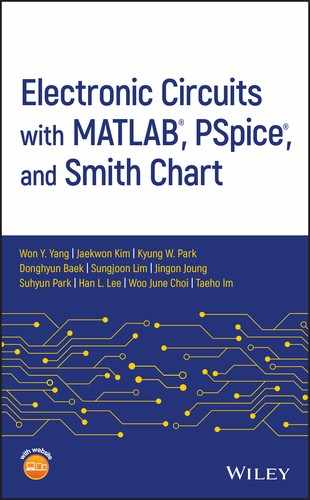Appendix D
Nonlinear/Differential Equations with MATLAB
D.1 Nonlinear Equation Solver <fsolve>
MATLAB has the built‐in function ‘fsolve(f,x0)’, which can give us a solution for a system of (nonlinear) equations. Suppose we have the following system of nonlinear equations to solve.

To solve this system of equations, we should rewrite as

and convert it into a MATLAB function defined in an M‐file, say, ‘f_d02.m’ as follows.
Then we type the following statements into the MATLAB Command Window.
>>x0=[0.8 0.2]; % Initial guess [0.8 0.2]>>x=fsolve('f_d02',x0,optimset('fsolve')) % with default parametersx = 2.0000 0.5000
If you see some warning message with the MATLAB solution obtained by using ‘fsolve()’ like this, you can change the value(s) of the optional parameters such as
- MaxFunEvals: Maximum number of function evaluations allowed
- MaxIter: Maximum number of iterations allowed
- TolFun: Termination tolerance on the function value
- TolX: Termination tolerance on x
by using the MATLAB command ‘optimset( )’ as follows.
options = optimset('param1',value1,'param2',value2,...)
For example, if you feel it contributive to better solution to set MaxFunEvals and TolX to 1000 and 1e‐8, respectively, you need to type the following MATLAB statements.
>>options = optimset('MaxFunEvals',1000,'TolX',1e-8);>>x=fsolve('f_d02',x0,options) % with new values of parametersx = 2.0000 0.5000
If you feel like doing cross‐check, you might use another MATLAB routine ‘Newtons( )’ which is defined in the next page.
>>x=Newtons('f_d02',x0) % Alternatively,x = 2.0000 0.5000
D.2 Differential Equation Solver <ode45>
Suppose we have a third‐order differential equation
We can rewrite this in a first‐order vector differential equation called a ‘state equation’ as

With this equation cast into a MATLAB function and saved as an M‐file named, say, “df_apd.m,”
we can type the following statements into the MATLAB Command Window to solve it:
>>[t,x]=ode45(@df_apd,[0 10],[1 2 3]); plot(t,x(:,1))% for time span [0,10]
